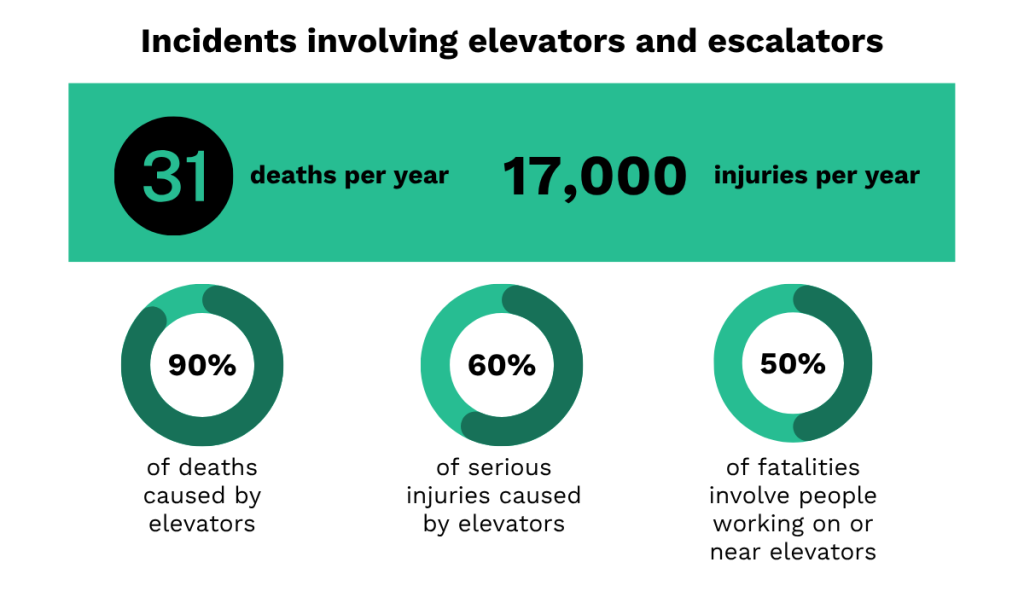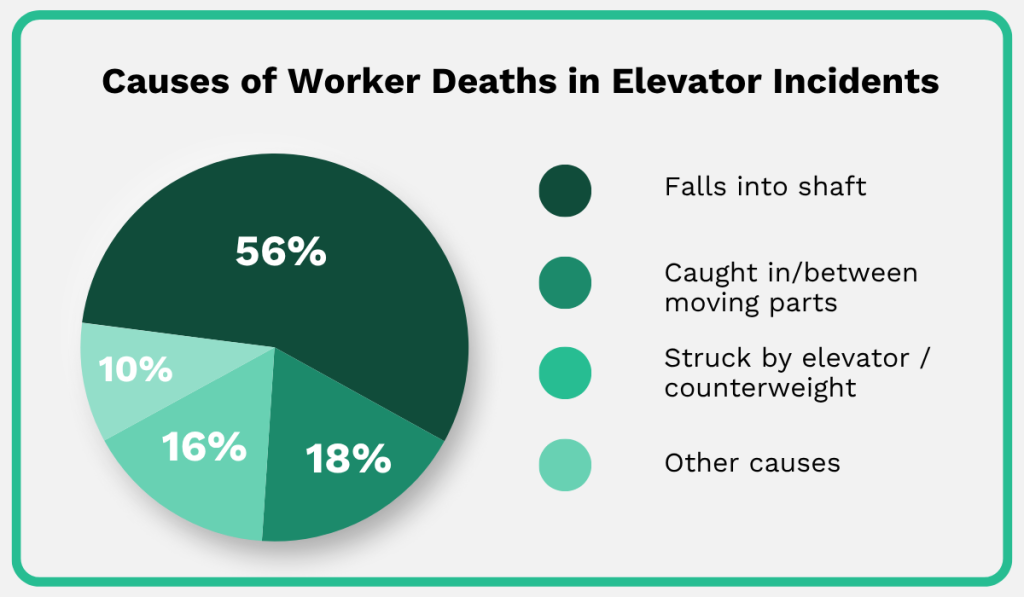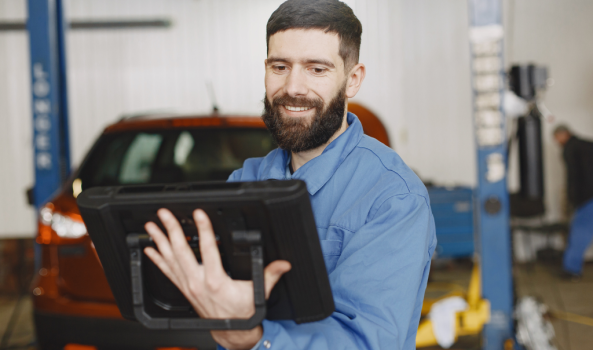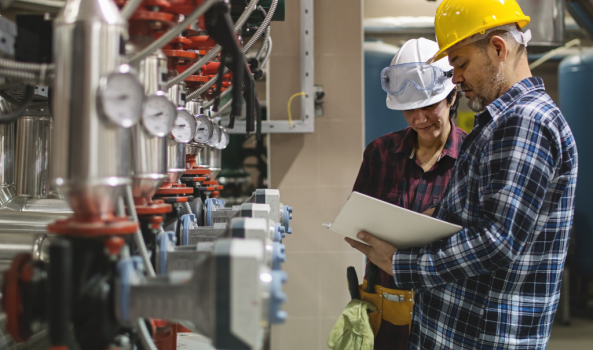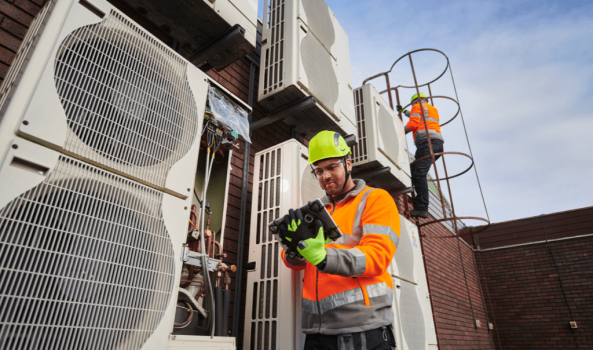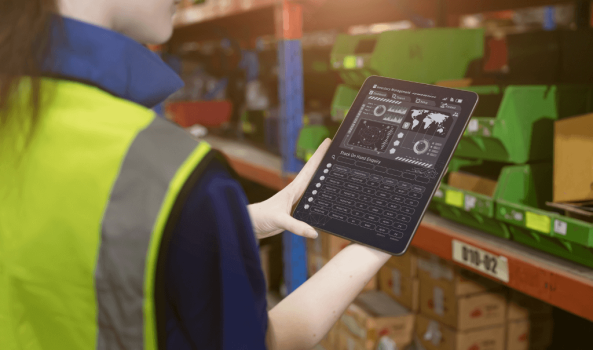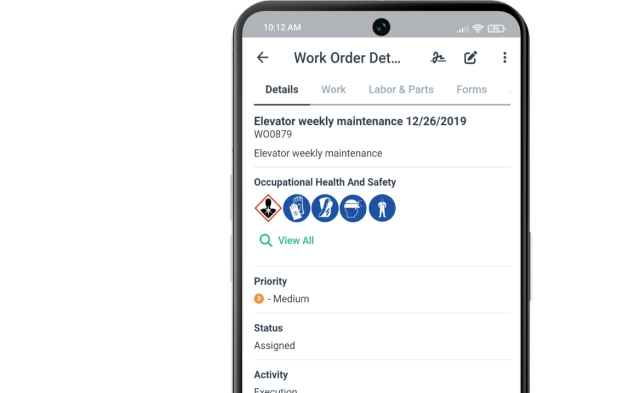Get a Free WorkTrek Demo
Let's show you how WorkTrek can help you optimize your maintenance operation.
Try for freeKey Takeaways:
- Elevator accidents cause more than 30 deaths a year in the U.S., with technicians accounting for about half of those fatalities.
- Proper PPE, well-implemented safety procedures, and strong training and communication protocols are essential to reducing risks.
- Digital checklists and maintenance management systems help ensure elevator maintenance is organized and safe.
While elevators are among the most reliable and safest vertical transportation devices, maintaining them comes with serious risks that can’t be ignored.
Whether you’re working in the shaft, machine room, or pit, one wrong move can lead to severe injury or worse.
That’s why safety should never be an afterthought.
In this article, we’ll walk you through practical steps every maintenance team can take to reduce hazards, protect technicians, and make sure every job ends with everyone going home safe.
1. Be Aware of Elevator Maintenance Hazards
Elevator maintenance technicians face a wide range of on-the-job hazards, many of them severe.
Falls from height, electrical shock, falling objects, trapping incidents, and mechanical injuries from moving parts are among the most common.
Confined spaces—often poorly ventilated—pose added risks, such as breathing difficulties or even suffocation.
A 2013 report by the Center for Construction Research and Training (CPWR) compiled multiyear U.S. data that underscores just how dangerous elevators can be:
As the statistics show, working on or near elevator systems exposes technicians to a variety of high-risk scenarios.
The most fatal incidents occur in elevator shafts, where unsecured access, missing fall protection, or falling objects can have deadly consequences.
More than half of all elevator-related worker deaths result from falls into the shaft alone.
Other serious hazards include being caught between moving parts or struck by the elevator car or its counterweights.
The same CPWR report breaks down the causes of elevator-related worker fatalities as follows:
Beyond the most common types of accidents, it’s important to recognize that different areas of an elevator system present different types of risks.
Shaft work carries the highest fall risk, especially during top-of-car access or rope work.
Pit areas are often cramped, poorly lit, and damp, making slips and exposure to hazardous substances more likely.
Machine rooms may contain high-voltage components and moving mechanical parts, increasing the risk of electrocution and crush injuries.
As the image below illustrates, electrical hazards in particular can occur throughout both the shaft and machine room environments.

Given these risks—and because every elevator job site is different—conducting a hazard assessment before work begins is essential.
This means identifying site-specific dangers, evaluating environmental conditions, and confirming that appropriate safety measures, such as lockout/tagout or fall protection, are in place.
Even routine elevator maintenance tasks can become dangerous without a clear understanding of the risks involved.
So, making hazard assessments a standard part of your safety protocol not only helps prevent life-threatening incidents but also ensures technicians are equipped with the right protective gear for the job.
2. Ensure Technicians Wear Proper PPE
As established earlier, elevator maintenance technicians face hazards ranging from falling objects to electrical shock, so wearing the right PPE should be non-negotiable.
Every technician’s gear bag should include a hard hat, safety glasses, cut-resistant gloves, steel-toe boots, and a high-visibility vest.
When working near live electrical components, additional arc flash protection is critical.
This includes flame-resistant (FR) clothing, voltage-rated gloves, and a face shield or hood.
As illustrated below, each piece of PPE serves a specific purpose, helping protect against debris, sharp edges, impact, or arc flashes.

Beyond standard PPE, fall protection gear is critical for elevator technicians.
Remember, falls are the leading cause of workplace injuries and fatalities in environments involving shaft access or overhead work.
That’s why OSHA requires fall protection for any employee working at heights of six feet or more, with similar rules enforced in many countries.
Technicians must be equipped with a complete fall arrest system, typically consisting of a full-body harness, a shock-absorbing lanyard, and a secure lifeline anchored to a stable point.
When properly worn and connected, this gear prevents deadly free falls and allows safe movement in vertical spaces like elevator shafts.
Here’s what each component does:

Of course, even the best PPE can fail if it’s damaged, worn out, or used incorrectly.
That’s why daily inspections are essential: technicians should check for frayed straps, cracked lenses, worn soles, or expired ratings before every shift.
Supervisors must also ensure team members are properly trained, especially when it comes to more specialized equipment like arc flash kits or fall arrest systems.

When in doubt, it’s always safer to replace questionable gear than to risk an avoidable injury.
In short, PPE is a frontline defense against the hazards elevator technicians face every day.
Knowing what to wear, how to wear it, and when to replace it isn’t just best practice—it can save lives.
3. Implement Safety Procedures
Elevator maintenance work often happens in tight, unpredictable spaces filled with moving machinery and high-voltage systems, making strict safety procedures a must.
Before any hands-on work begins, technicians need to follow a clear set of precautions to control hazards and prevent unexpected elevator or equipment movement.
Chief among these is de-energizing the elevator system.
Whether it’s an electrical circuit, hydraulic system, or mechanical motor, nothing should be left live.
That’s where Lockout/Tagout (LOTO) measures become essential, helping workers isolate power sources and verify that all systems are safely shut down.

Beyond LOTO procedures, technicians must verify that:
- All power sources have been disconnected
- Emergency stop switches are engaged
- Control fuses have been removed
With internal systems secured, it’s just as important to control access to the physical work area.
Elevator shafts, pits, and machine rooms pose serious fall and crush hazards if left unmarked or open.
That’s why safety signs, cones, and physical barriers should always be placed at entry points to alert others and restrict unauthorized access.
In some cases, guardrails or temporary covers may also be necessary—especially during work involving open hoistways (i.e., shafts) or ceiling hatches.
These visible precautions help establish a clearly defined safety perimeter, protecting both workers and bystanders.
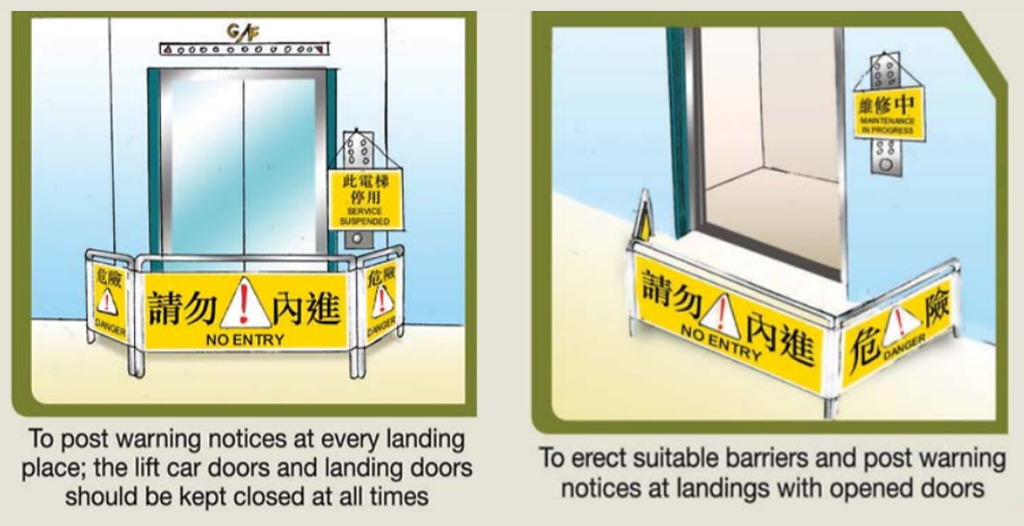
Of course, visual warnings are only one part of the safety equation.
Strict procedural controls are just as important, especially when working near shafts, pits, or inside machine rooms.
For instance, keeping the escape hatch on top of the elevator car open will automatically engage the safety interlock, preventing the elevator from operating during maintenance.
Similarly, leaving the ground-floor elevator doors open (with warning signs and barriers in place) both signals that maintenance is in progress and physically disables the system from running.
When performing cartop work, technicians must also ensure proper guardrails are installed and limit the number of personnel on the car to avoid overcrowding and ensure safe movement.

In most cases, at least two qualified personnel should be present for any shaft or cartop work.
Beyond these procedural safeguards, environmental hazards shouldn’t be overlooked.
Poor lighting can obscure trip hazards, while slippery floors—caused by oil, water, or cleaning fluids—greatly increase the risk of falls.
Exposure to dust, fumes, or cleaning chemicals in confined areas may also pose respiratory risks, making breathing masks essential in certain situations.
Technicians should also carry a well-stocked first aid kit to treat minor injuries or provide immediate care in case of a more serious incident.
Next, we’ll look at how proper training, clear communication, and the use of maintenance checklists further strengthen elevator safety procedures.
4. Secure Adequate Training and Communication
Thorough safety training is essential before any technician steps into an elevator shaft, machine room, or onto a car top.
New hires should receive instruction on PPE use, emergency procedures, equipment handling, and all known hazards related to elevator systems.
For more experienced technicians, hands-on drills, periodic refresher sessions, and regular safety talks help reinforce safe practices and build confidence in high-risk scenarios.
Today, advanced tools like virtual reality (VR) simulators are increasingly used to let trainees explore elevator components in a safe, controlled environment before ever stepping on-site.
As Dan Vinette, Program Director of the Canadian Elevator Industry Educational Program (CEIEP), explains:

Of course, even the best training can fall short without strong communication.
During elevator maintenance, technicians must be able to reach each other instantly, especially when working at different levels or in confined spaces.
The Casebook on Fatal Accidents in Elevators documents a tragic incident where an apprentice was assigned to work alone in the pit.
While manually opening the ground-floor door, the elevator car suddenly ascended. He tried to activate the emergency brake—but it was too late.
The case analysis, in addition to noting inadequate training and a lack of safety, concluded:
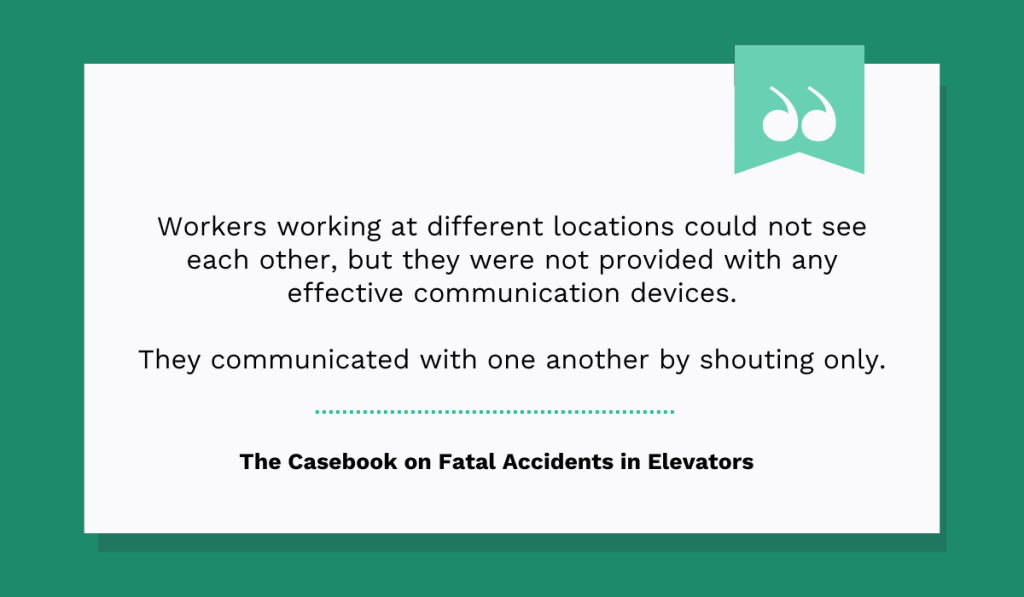
To prevent tragedies like this, two-way radios or walkie-talkies are essential.
But why not rely on smartphones, which are nearly universal today?
Because inside shafts or pits, the mobile signal is often weak or completely lost. Smartphones are also slower to operate and more vulnerable to battery failure in critical moments.
Overall, comprehensive training combined with reliable communication is essential to creating a safe and responsive work environment during elevator maintenance.
5. Create an Elevator Maintenance Checklist
Even the most experienced technicians benefit from clear, structured checklists, and elevator maintenance involves dozens of safety-critical steps that must be completed in the right order.
Without a checklist, it’s easy to overlook essential details, especially during high-risk inspections or time-sensitive repairs.
That’s why it’s best to develop a task-specific elevator maintenance checklist covering inspection steps, safety verifications, required PPE, and documentation.
Many templates are available online to help build your own.
For example, here’s a checklist that emphasizes both physical inspection and safety compliance:
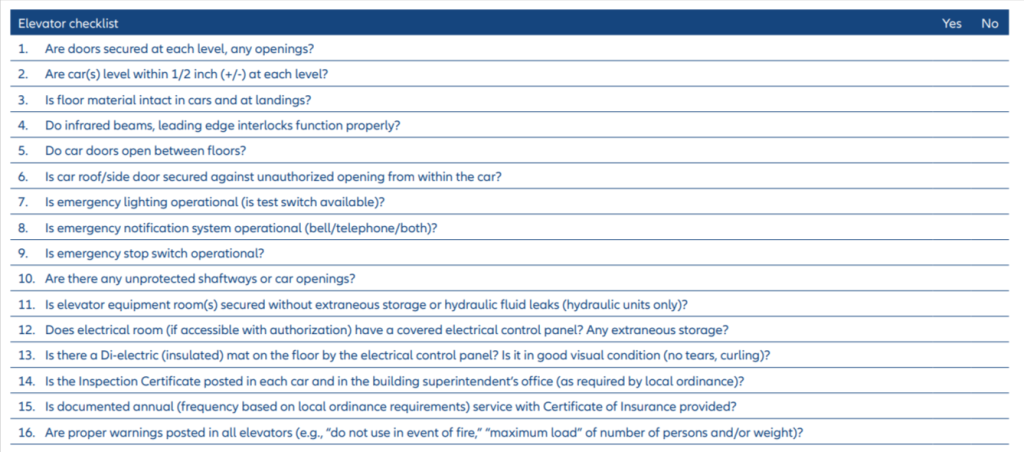
Of course, checklists shouldn’t be treated as a tick-the-box exercise, but rather as tools that actively guide technicians through safe, step-by-step procedures.
A well-designed checklist should also include location-based tasks such as those specific to the car, shaft, pit, and machine room.
This helps teams verify conditions before starting work and confirm that everything is safe before returning the elevator to service.
To illustrate, below is an excerpt from a location-based elevator maintenance checklist:

Technicians should also document any observations directly on the checklist for follow-up or future inspection reference.
This both supports accountability and helps identify recurring issues or emerging risks over time.
For best results, checklists should be reviewed and updated regularly, especially when new equipment is installed, regulations change, or lessons are learned from past incidents.
6. Use CMMS for Clear Maintenance Protocols
Last but not least, consider using a computerized maintenance management system (CMMS) to digitize and streamline your elevator maintenance protocols.
A CMMS lets you create work orders, schedule recurring inspections, assign preventive maintenance tasks, check tool and supply availability, and more.
It replaces paper-based records with centralized digital access, helping keep your team aligned, organized, and accountable.
For example, with our CMMS, WorkTrek, technicians can receive new work orders, review past service logs, add post-maintenance notes, and check their work schedules—all from any internet-connected device.
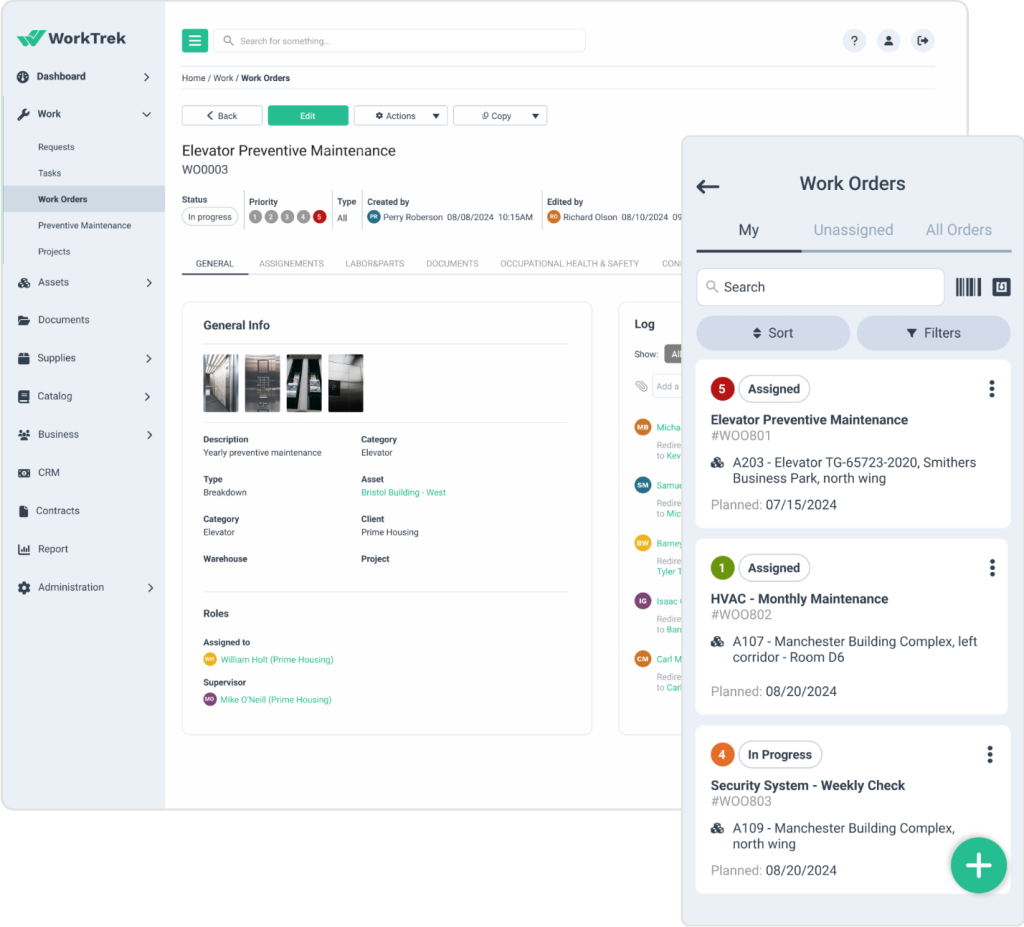
Digital checklists are another powerful feature that WorkTrek offers.
You can create location-based forms that technicians complete on-site, saving time and ensuring no inspection point is missed.

They eliminate guesswork, standardize inspections, and ensure full traceability for compliance or audits.
As for those in charge of elevator upkeep and safety—such as facility managers—they can use CMMS on their mobile devices to submit work requests on the go whenever an elevator needs attention.
They can describe the issue, provide details, and even upload photos without incurring any additional cost to you.
A good CMMS also supports other safety-enhancing features.
For instance, users can access a list of required personal protective equipment (PPE) for elevator maintenance, ensuring technicians are properly equipped before beginning any task.

Finally, a CMMS typically allows you to set automated reminders for upcoming safety checks or training certifications, so nothing slips through the cracks.
Beyond improving safety, a CMMS also significantly boosts the efficiency of your maintenance operations, reducing downtime and minimizing disruptions.
Whether you manage a few elevators or an entire fleet, the right solution helps keep your maintenance organized, safe, and fully documented.
Conclusion
Elevator maintenance is a complex, safety-critical process that demands diligence, the right tools, and clear procedures.
By combining proven safety practices with modern solutions like CMMS, you can protect technicians, reduce hazards, and keep operations running smoothly.
Ultimately, well-planned maintenance safeguards both elevator users and the people who work on them.




